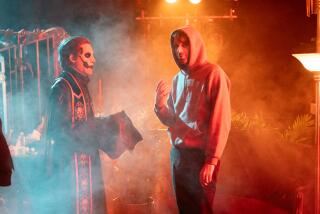Spectral visitations lift the spirits of a crop of movie heroes

Dead people are having a field day this year at the movies. Horror film ghosts continue as always to provide jump scares by the dozens, but deceased souls also serve more nuanced dramatic purposes, deepening story lines by summoning the past. In âCandyman,â the original 1986 boogeyman eviscerates victims once again, but this time, the mayhem serves as explicit reckoning for the racist brutality suffered by ghostly Daniel Robitaille (portrayed by original Candyman Tony Todd).
âI Was a Simple Manâ depicts Masao Matsuoshi (Steve Iwamoto) quietly receiving spiritual succor from his long-dead wife (Constance Wu) after getting diagnosed with terminal cancer.
And then thereâs âRespect.â
The Aretha Franklin biopic pegs its turning point to a spectral intervention by the singerâs long-dead mother Barbara (Audra McDonald). Ghost Mother materializes when adult Aretha hits rock bottom in her personal life. Depressed, bitter, drinking whiskey alone in her unkempt home, Aretha (Jennifer Hudson) suddenly sees her mother, smiling and singing at the piano just as she remembers from childhood.
âRespectâ co-writer Tracey Scott Wilson remembers brainstorming the visitation sequence with director Liesl Tommy. âThereâs this saying in TV that sometimes joke pitches turn into real pitches, and thatâs what happened with âRespect,ââ she says. âLiesl and I felt there needed to be a moment in the third act where Aretha grapples with the death of her mother and at some point, Liesl said, âWhat if she comes back as a ghost?â The more we thought about it, the more it started to make sense, especially in the context of Arethaâs faith â the idea that the body dies but the spirit lives on. That was the context, and I started to think about how to incorporate it in a way that wouldnât be cheesy.â
Wilson (âThe Americans,â âFosse/Verdonâ) drew on her own experience to infuse the visitation scene with emotional heft. âHaving lost both of my parents, I mined my own grief to create these moments. The day we filmed that scene was particularly powerful for me.â
In âRespect,â Ghost Mother speaks not a word, expressing herself solely through singing and a hug. âArethaâs entire being is grounded in music, so it just made sense to us that her mother would communicate by singing one of her favorite songs,â Wilson says. Ghost Mother inspires Aretha to quit drinking and fortifies her connection to the church, leading to her triumphant recording of the Grammy-winning âAmazing Graceâ album. Wilson says, âGetting that healing from her mother, it became about Aretha wanting to extend that healing to other people who were in pain.â
âSpencerâ also conjures an emotional support ghost for its real-life heroine, but in the self-described âfable from a true tragedy,â the phantom appears to Princess Diana (Kristen Stewart) in the form of Queen Anne Boleynâs 455-year old ghost.
Diana, rumored to be âcracking up,â encounters Boleyn in a frigid 19th century estate while she endures a dismal Christmas holiday with the royal family. Screenwriter Steven Knight (âPeaky Blindersâ), who collaborated with director Pablo LarraĂn a few months after reading âThe Life and Death of Anne Boleynâ about King Henry VIIIâs famously beheaded second wife, says the queen âshowed upâ on the page once he started writing the screenplay. âI wanted this whole thing to feel like a fairy tale and most fairy tales are usually horror stories as well,â Knight notes. âWith âSpencer,â itâs a princess captured in a castle. Someone leaves the Anne Boleyn book on her bed, [essentially] saying, âYou could compare yourself to Anne Boleynâ as a sort of threat.â
Diana reads the book, sees an ancient portrait of the 16th century queen, then glimpses visions of Anne Boleyn during high-stress moments that culminate in the deserted house where the princess grew up. âDiana was accused of throwing herself down the stairs to kill herself,â Knight says. âThat was a leaked piece of information. I wanted to take Diana to the top of the stairs and then have Anne Boleyn be the one who says, âDonât do it! Donât let them get to you!â We see Diana fall, but then we see that, in fact, she didnât fall because Anne Boleyn stopped her from doing it.â
If Englandâs bloody history inflames Diana Spencerâs imagination, British nostalgia primes the spectral pump for director and co-writer Edgar Wrightâs âLast Night in Soho.â NaĂŻve country girl Eloise (Thomasin McKenzie), haunted by her late motherâs suicide, idealizes the swinging â60s. She moves to London for fashion school and rents a room in a musty old boarding house run by a landlady (Diana Rigg) who remembers Soho in its heyday.
Do old buildings house old spirits? Wright likes the idea. âI grew up with a mother who felt presences or sometimes saw ghosts in old buildings, indeedâŻeven in our family home,â he says. âI wanted to have the same experience myself. And when I moved to London, I found it to be haunted by âghosts,â not just by the stain of the terrible tragedies and crimes within its buildings or on its streets, but also from its own cultural legacy. Iâd often dream about going back to the â60s as a cultural time traveler, but then Iâd wonder if that was less an escape and more just a retreat from modern life.â
Eloise starts dreaming every night about Sandie (Anya Taylor-Joy), a spirited showgirl who allows her to tag along on time travel adventures circa 1965. When Eloiseâs dreams turn toxic, ghostly âShadow Menâ with blurry faces go on the attack. Wright says, âThe keyâŻdetails of these specters is that you cannot make out their faces. This is based on very real research showing that victims of trauma choose to erase the faces ofâŻtheir attackers as a copingâŻmechanism. This overlaps with the sleepâŻparalysisâŻphenomenon, where people are haunted by faceless figures in their waking dreams as a way of compartmentalizing real terrors.ââŻ
More to Read
From the Oscars to the Emmys.
Get the Envelope newsletter for exclusive awards season coverage, behind-the-scenes stories from the Envelope podcast and columnist Glenn Whippâs must-read analysis.
You may occasionally receive promotional content from the Los Angeles Times.










